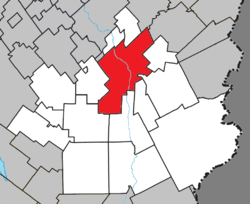Saint-Georges, Quebec
| Saint-Georges | ||
|---|---|---|
| City | ||
|
A view of Saint-Georges, with the CEGEP at the top of the hill. | ||
| ||
 Location within Beauce-Sartigan RCM. | ||
 Saint-Georges Location in southern Quebec. | ||
| Coordinates: 46°07′N 70°40′W / 46.117°N 70.667°WCoordinates: 46°07′N 70°40′W / 46.117°N 70.667°W[1] | ||
| Country |
| |
| Province |
| |
| Region | Chaudière-Appalaches | |
| RCM | Beauce-Sartigan | |
| Constituted | September 26, 2001 | |
| Government[2] | ||
| • Mayor | Claude Morin | |
| • Governing Body | Saint-Georges City Council | |
| • MP | Maxime Bernier (Beauce, CPC) | |
| Area[2][3] | ||
| • City | 202.40 km2 (78.15 sq mi) | |
| • Land | 198.21 km2 (76.53 sq mi) | |
| • Metro[4] | 355.62 km2 (137.31 sq mi) | |
| Population (2011)[3] | ||
| • City | 31,173 | |
| • Density | 157.3/km2 (407/sq mi) | |
| • Metro[4] | 34,642 | |
| • Metro density | 97.4/km2 (252/sq mi) | |
| • Pop 2006-2011 |
| |
| • Dwellings | 14,735 | |
| Time zone | EST (UTC−5) | |
| • Summer (DST) | EDT (UTC−4) | |
| Postal code(s) | G5Y, G5Z, G6A | |
| Area code(s) | 418 and 581 | |
| Highways |
| |
| People | Georgiens, Georgiennes | |
| Website |
www saint-georges | |
Saint-Georges is a city in the province of Quebec. It is the seat of Beauce-Sartigan Regional County Municipality, part of the Chaudière-Appalaches region. The population was 31,173 as of the Canada 2011 Census. Route 173 runs through Saint-Georges Est (where it is known as Boulevard Lacroix) and heads south to the border with Maine, USA.
The name of the parish and of the city, Saint-Georges, is in homage to George Pozer, the fourth seigneur of Aubert-Gallion.[5]
The Beauce-Etchemin School Board (Commission scolaire de la Beauce-Etchemin) has its headquarters on 118th Street. Saint-Georges is home to the Cégep Beauce-Appalaches.
In 2002, it amalgamated with Saint-Georges-Est (pop. 4,110), Aubert-Gallion (pop. 2,444) and Saint-Jean-de-la-Lande (pop. 786).
It is home to one of the few inflatable dams, introduced to raise the water level of the Chaudière River for water-based activities and to make the riverside more attractive. Pedestrian bridges were also built over the river as part of the same project.
Economy
Although a relatively small city, Saint-Georges is often considered the Metropolis of Beauce Region because it's the largest city in the region. Saint-Georges is an important manufacturing centre, including textiles, steel forgings, garage doors, bicycles and truck trailers. The city has a wide array of local and national retailers and restaurants, as well as many services including financial institutions, schools of different levels, medical clinics, a hospital and several others that are not found elsewhere in the region. Carrefour Saint-Georges is the largest shopping mall in town and in the region.
Saint-Georges is the headquarters of the intercity bus company Autocars La Chaudière, which provides bus services in the Beauce Region to Quebec City. The city also has a regional airport. The extension of Autoroute 73 to the city has been under discussion for almost thirty years, but the project has not yet been completed; the highway has been extended only to Beauceville, Quebec, approximately 11 kilometres (7 mi) to the north, since November 2007. Assessments of the environmental and agricultural impacts of the next segment to Saint-Georges were underway as of August 2008.[6]
Demographics
In 2006, Saint-Georges was 99.6% White, 0.2% Aboriginal, and 0.2% Visible Minorities Visible Minority.
History
The history of Saint-Georges goes back to the late seventeenth century, at which point the region was inhabited principally by "Algonquin Indians". The first European presence recorded is that of a Jesuit missionary called Father Gabriel Druillettes who made three visits in 1646, 1650 and, finally, in 1651, but there was no colonial settlement established at this time. By the middle of the next century, however, two colonial "seigneuries" had been established on the present site of Saint-Georges: these were Aubin-de-l'Isle and Aubert-Gallion.[7] Records indicate that in 1760 one of these, Aubert-Gallion, passed into the hands of Marie-Anne Josephte de l'Estrigant de St-Martin and of her daughter Charlotte-Marie-Anne-Joseph Aubert de la Chesnaye. The two heiresses sold their inheritance in 1768 to William Grant, an Englishman with ambitions to become a major Canadian landowner. Grant died in 1805 or 1807 (sources differ) and the estate was sold again, this time to the German (at least by birthplace), Johann Georg Pfotzer. The canonical parish of Saint-Georges was created in 1835,[8] and the secular parish/municipality in 1856.
Twin towns
- Lisieux, France since 1996
See also
References
- ↑ Reference number 80047 of the Commission de toponymie du Québec (French)
- 1 2 Geographic code 29073 in the official Répertoire des municipalités (French)
- 1 2 "(Code 2429073) Census Profile". 2011 census. Statistics Canada. 2012.
- 1 2 "(Code 428) Census Profile". 2011 census. Statistics Canada. 2012.. The census agglomeration consists of Saint-Georges, Lac-Poulin, Notre-Dame-des-Pins, Saint-Benoît-Labre, Saint-Simon-les-Mines. In the 2006 census, the census agglomeration had not included Notre-Dame-des-Pins or Saint-Simon-les-Mines.
- ↑ Garant, André (1985). À l'ombre du clocher-- Saint-Georges-de-Beauce : 150e anniversaire de l'érection canonique, 1835-1985 (in French). Fabrique Saint-Georges-de-Beauce. ISBN 978-2-9800513-0-2. OCLC 16060860.
- ↑ "Prolongement de l'autoroute Robert-Cliche (73)" (in French). Transports Québec. Retrieved 2008-08-26.
- ↑ http://www.saint-georges.ca/A_propos_de_la_ville/Notre_histoire/
- ↑ http://fr.wikisource.org/wiki/Les_Seigneurs_et_premiers_censitaires_de_St-Georges-Beauce_et_la_famille_Pozer/Texte_entier
External links
- Official site (French)
- Beauce-Etchemin School board site (French)
- EnBeauce.com Portal (French)

.svg.png)
